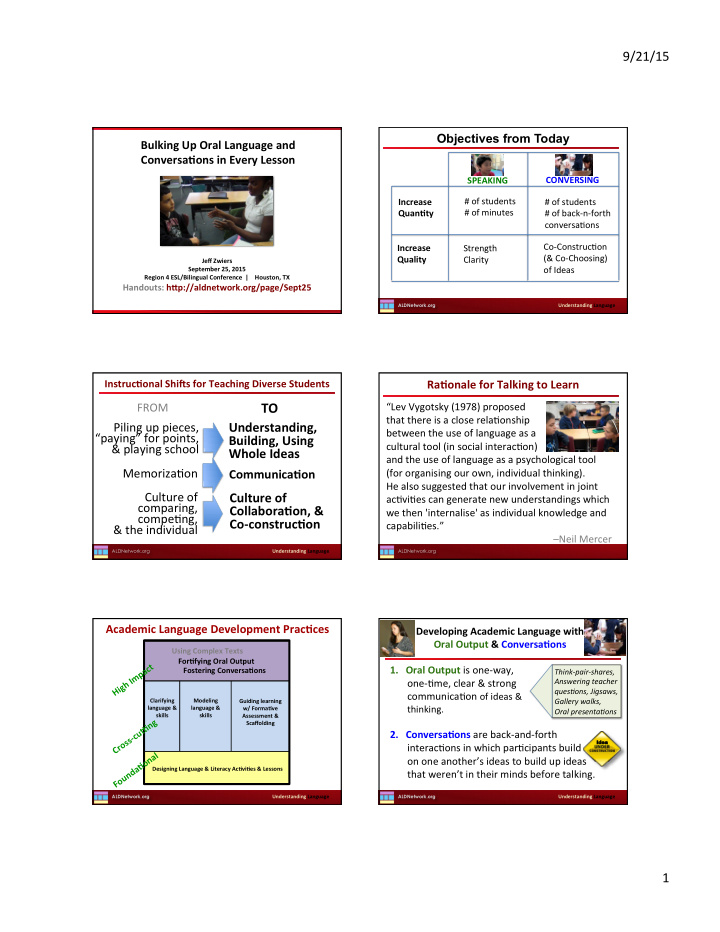



9/21/15 ¡ Objectives from Today Bulking ¡Up ¡Oral ¡Language ¡and ¡ ConversaPons ¡in ¡Every ¡Lesson ¡ CONVERSING ¡ SPEAKING ¡ # ¡of ¡students ¡ Increase ¡ # ¡of ¡students ¡ # ¡of ¡minutes ¡ QuanPty ¡ # ¡of ¡back-‑n-‑forth ¡ conversa?ons ¡ Co-‑Construc?on ¡ Increase ¡ Strength ¡ (& ¡Co-‑Choosing) ¡ Quality ¡ Clarity ¡ Jeff ¡Zwiers September ¡25, ¡2015 ¡ of ¡Ideas ¡ Region ¡4 ¡ESL/Bilingual ¡Conference ¡ ¡| ¡ ¡ ¡ ¡Houston, ¡TX ¡ Handouts: ¡hJp://aldnetwork.org/page/Sept25 ¡ ALDNetwork.org ALDNetwork.org Understanding ¡Language ¡ InstrucPonal ¡ShiZs ¡for ¡Teaching ¡Diverse ¡Students ¡ RaPonale ¡for ¡Talking ¡to ¡Learn ¡ ¡ ¡ ¡ ¡FROM ¡ ¡ ¡ ¡ ¡ ¡ ¡ ¡ ¡ ¡ ¡ TO ¡ “Lev ¡Vygotsky ¡(1978) ¡proposed ¡ ¡ that ¡there ¡is ¡a ¡close ¡rela?onship ¡ ¡ ¡ ¡ Understanding, ¡ Piling ¡up ¡pieces, ¡ between ¡the ¡use ¡of ¡language ¡as ¡a ¡ ¡ “paying” ¡for ¡points, ¡ Building, ¡Using ¡ cultural ¡tool ¡(in ¡social ¡interac?on) ¡ ¡ & ¡playing ¡school ¡ Whole ¡Ideas ¡ and ¡the ¡use ¡of ¡language ¡as ¡a ¡psychological ¡tool ¡ Memoriza?on ¡ CommunicaPon ¡ (for ¡organising ¡our ¡own, ¡individual ¡thinking). ¡ ¡ He ¡also ¡suggested ¡that ¡our ¡involvement ¡in ¡joint ¡ Culture ¡of ¡ Culture ¡of ¡ ac?vi?es ¡can ¡generate ¡new ¡understandings ¡which ¡ comparing, ¡ ¡ CollaboraPon, ¡& ¡ we ¡then ¡'internalise' ¡as ¡individual ¡knowledge ¡and ¡ ¡ compe?ng, ¡ ¡ Co-‑construcPon ¡ capabili?es.” ¡ ¡ ¡ ¡ ¡ ¡ ¡ ¡ ¡ ¡ & ¡the ¡individual ¡ ¡–Neil ¡Mercer ¡ ALDNetwork.org Understanding ¡Language ¡ ALDNetwork.org Academic ¡Language ¡Development ¡PracPces ¡ ¡ Developing ¡Academic ¡Language ¡with ¡ ¡ ¡ Oral ¡Output ¡& ¡ConversaPons ¡ Using ¡Complex ¡Texts ¡ ¡ ForPfying ¡Oral ¡Output ¡ High ¡Impact ¡ 1. Oral ¡Output ¡is ¡one-‑way, ¡ ¡ Fostering ¡ConversaPons ¡ Think-‑pair-‑shares, ¡ ¡ one-‑?me, ¡clear ¡& ¡strong ¡ ¡ Answering ¡teacher ¡ ques5ons, ¡Jigsaws, ¡ communica?on ¡ of ¡ideas ¡& ¡ ¡ Gallery ¡walks, ¡ ¡ Clarifying ¡ Modeling ¡ Guiding ¡learning ¡ thinking. ¡ ¡ ¡ language ¡& ¡ language ¡& ¡ w/ ¡FormaPve ¡ Oral ¡presenta5ons ¡ skills ¡ ¡ ¡ skills ¡ Assessment ¡& ¡ Cross-‑cu_ng ¡ ¡ Scaffolding ¡ 2. ConversaPons ¡ are ¡back-‑and-‑forth ¡ Idea dea interac?ons ¡in ¡which ¡par?cipants ¡build ¡ ¡ FoundaPonal ¡ on ¡one ¡another’s ¡ideas ¡to ¡build ¡up ¡ideas ¡ ¡Designing ¡Language ¡& ¡Literacy ¡AcPviPes ¡& ¡Lessons ¡ that ¡weren’t ¡in ¡their ¡minds ¡before ¡talking. ¡ ¡ ALDNetwork.org Understanding ¡Language ¡ 3. ¡ ALDNetwork.org Understanding ¡Language ¡ 1 ¡
9/21/15 ¡ TransiPon ¡Improv ¡AcPvity: ¡Pro-‑Con ¡ ¡ Topics: ¡ ¡ ¡ ¡ ¡ ¡ Camping, ¡Shopping, ¡Traveling, ¡TV, ¡Uniforms, ¡ ¡ Computers, ¡Superheroes, ¡Cars, ¡Conferences, ¡ Developing ¡Oral ¡Output ¡ ¡ Tes?ng, ¡Internet, ¡Cell ¡phones, ¡Video ¡games ¡ ¡ with ¡ Transi5ons: ¡ ¡ However, ¡ TRANSITION ¡IMPROV ¡ ¡ ¡ ¡ ¡ ¡ ¡ ¡ ¡ ¡ ¡ ¡On ¡the ¡other ¡hand, ¡ ¡ ¡ ¡ ¡ ¡ ¡ ¡ ¡ ¡ ¡Then ¡again, ¡ ¡ ¡ ¡ ¡ ¡ ¡ ¡ ¡ ¡ ¡ ¡ ¡ ¡ ¡ ¡ ¡ ¡ ¡ ¡ ¡ ¡ but ¡ ¡ Activities ¡ PC ¡Frames: ¡ ¡ One ¡advantage ¡is ¡… ¡For ¡example, ¡… ¡ ¡ ¡ ¡ ¡ ¡ ¡ ¡Another ¡posiPve ¡of ¡… ¡is… ¡because… ¡ ¡ ¡ ¡ ¡A ¡negaPve ¡aspect ¡of ¡___ ¡is ¡… ¡ ¡ ¡ ¡ ¡In ¡spite ¡of ¡the ¡posiPves ¡of ¡_____, ¡ ¡ A ¡& ¡B, ¡Lean? ¡ ALDNetwork.org Understanding ¡Language ¡ TransiPon ¡Improv ¡Features ¡& ¡Advantages ¡ TransiPon ¡Improv ¡ (Similar-‑Different) ¡ ¡ ¡ ¡ Animal cells Plant Cells Topic: ¡ ¡ ¡ ¡ ¡ ¡ Plant ¡cells ¡& ¡ ¡ What ¡does ¡this ¡type ¡of ¡acPvity ¡do ¡for ¡ ¡ ¡ students? ¡ ¡ ¡ ¡animal ¡cells ¡ ¡ No cell wall Cell wall d ¡ ¡ ¡ Ribosomes • Face-‑to-‑face ¡communica?on ¡with ¡an ¡ ¡ (make protein) Rectangular shape Round shape ¡ informa?on ¡gap ¡ Mitochondria Transi5ons: ¡ ¡ However, ¡ ¡ (turns nutrients ¡ Chloroplasts • Real ¡?me ¡thinking ¡to ¡speaking ¡ Centrioles into energy) ¡ ¡ ¡ ¡ ¡ ¡ ¡ ¡ ¡ ¡On ¡the ¡other ¡hand, ¡ ¡ (produce carbohydrates ¡ (pull chromosomes from using photosynthesis) • Structure ¡so ¡both ¡need ¡to ¡listen ¡and ¡speak ¡ ¡ ¡ ¡ ¡ ¡ ¡ ¡ ¡ ¡ ¡Then ¡again, ¡ ¡ ¡ ¡ ¡ ¡ ¡ ¡ ¡ ¡ ¡ ¡ ¡ ¡ ¡ ¡ ¡ ¡ ¡ ¡ ¡ ¡ but ¡ ¡ nucleus during mitosis) ¡ ¡ • Academic ¡language ¡supports ¡ One ¡turn ¡with; ¡next ¡turn ¡without ¡ SD ¡Frames: ¡ ¡ Unlike ¡animal ¡cells, ¡plant ¡cells ¡have ¡____, ¡which ¡… ¡ • Use ¡evidence ¡ ¡ ¡ ¡ ¡Plant ¡& ¡animal ¡cells ¡both ¡have ¡____, ¡which ¡serve ¡to… ¡ • See ¡mul?ple ¡perspec?ves ¡ ¡ ¡ ¡ ¡ … ¡are ¡similar ¡to ¡____ ¡in ¡that ¡they ¡both ¡_____ ¡ ¡ ¡ ¡ ¡ ¡ ¡Animal ¡cells ¡differ ¡from ¡plant ¡cells ¡in ¡that ¡_____ ¡ ¡ ¡ ¡ ¡ ¡ ALDNetwork.org Understanding ¡Language ¡ ALDNetwork.org Understanding ¡Language ¡ OUTPUT ¡ ACTIVITY: ¡TransiPon ¡Improv: ¡ (Two ¡Views) ¡ ¡ Developing ¡Oral ¡Output ¡ ¡ Views: ¡ ¡ ¡ ¡ ¡ ¡ Patriots ¡ with ¡ ¡ ¡ ¡ ¡Loyalists ¡ “STRONGER ¡Y ¡CLEARER ¡ ¡ Transi5ons: ¡ ¡ However, ¡ EACH ¡TIME” ¡Activities: ¡ ¡ ¡ ¡ ¡ ¡ ¡ ¡ ¡ ¡ ¡On ¡the ¡other ¡hand, ¡ ¡ ¡ ¡ ¡ ¡ ¡ ¡ ¡ ¡ ¡Then ¡again, ¡ ¡ ¡ ¡ ¡ ¡ ¡ ¡ ¡ ¡ ¡ ¡ ¡ ¡ ¡ ¡ ¡ ¡ ¡ ¡ ¡ ¡ but ¡ ¡ • Opinion ¡Continuum ¡ Frames: ¡ The ¡___ ¡thought ¡that ¡… ¡ • Stronger-‑Clearer ¡Grid ¡ ¡ ¡ ¡ ¡ ¡Many ¡___ ¡believed ¡that… ¡ ¡ ¡ ¡ ¡ ¡ ¡ ¡ ¡A ¡different ¡perspecPve ¡held ¡by ¡___ ¡was ¡that… ¡ ¡ ¡ ¡ ¡In ¡the ¡eyes ¡of ¡___... ¡ ALDNetwork.org Understanding ¡Language ¡ 2 ¡
Recommend
More recommend